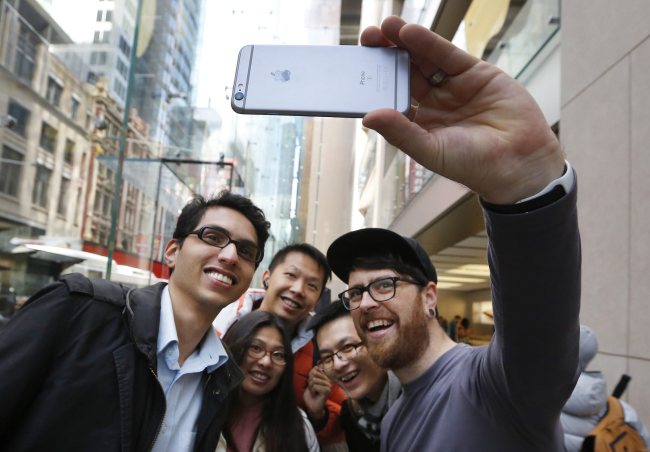How many iPhones can Apple Inc. sell? With the company hitting new sales records with each annual release, that’s a question facing chief executive officer Tim Cook as the latest batch of handsets hits stores on Friday around the world.
The latest models, following last year’s hugely popular design overhaul that added bigger screens, may not match the success of previous releases, according to analysts.

Demand for the new iPhones appears to be lower than last year, “possibly meaningfully so,” said Andy Hargreaves, an analyst at Pacific Crest Securities who studied Google search data, device shipment times and third-party surveys. Analysts at Sanford C. Bernstein and Co. and RBC Capital Markets also raised concerns about iPhone growth. Since 2013, iPhone sales have increased an average of about 35 percent each quarter. In October to December alone last year, Apple sold 74.6 million iPhones. That’s about 34,000 iPhone purchases per hour.
Expectations are tempered partially because the gadget is at the point in its two-year design cycle that includes less dramatic changes. In the first year, Apple generally overhauls the device’s hardware, including its look and feel. For the following year’s model, designated with an “s” tacked on to the number, the Cupertino, California-based company makes more subtle improvements.
The iPhone 6s and 6s Plus look like last year’s versions but include new features such as 3D Touch, which provides a shortcut for checking mail, taking pictures and other functions when the user presses down on the screen. Apple also added an improved camera and a zippier processor.
Whether Apple can match last year’s demand will be determined when the new handsets start hitting stores in New Zealand, Australia, Japan, Singapore, China, Hong Kong, France, Germany, the UK, Canada, the US and Puerto Rico. The handsets will be on sale in more than 130 countries by year-end, according to Apple.
Sydney rain
In Sydney, hundreds queued in heavy rain outside Apple’s city-center store to be among the world’s first buyers. Dozens of staff counted down to the 8am opening before customers walked in, many of them recording the moment on their smartphones.
Lindsay Handmer, a freelance technology journalist from western Sydney, camped for 18 days in front of the store to be the first in line. He showered at a local gym and used the toilets at a nearby McDonald’s restaurant. He plans to auction his two new phones for a charity that helps the homeless.
“There have been good points and bad points,” Handmer, 32, said in an interview describing his stay on the streets. “I’ve been heckled and I’ve seen people overdosing.”
Zihao Niu, a Sydney-based business student from Beijing, waited for five hours. He said he always buys “s” model iPhones to avoid the teething problems from more radical overhauls and is especially drawn to the latest model’s pressure-sensitive screen.
“I think it’s wonderful,” said the 18-year-old. “I want to seize the moment and enjoy it.”
A heavyweight
A smooth release is critical for Apple, which generates more than 60 percent of its revenue from the phone. Cook is attempting to expand other businesses, but the portion of sales coming from the iPhone continues to grow. The Apple Watch hasn’t become a mainstream hit since it was released earlier this year and iPad sales are in decline.
The iPhone’s weight in Apple’s results has put further investor focus on the device’s performance. The stock through Wednesday was down 14 percent from its high in February, in part because of concerns that the device can’t continue its run of unprecedented growth.
Apple last week predicted it would top last year’s opening-weekend sales record of 10 million units, although that figure is boosted by availability this year in China, which wasn’t part of the initial rollout last year. A better gauge for how the device is selling will come in January, when the company reports sales for the holiday quarter.
Pricing options in the US vary more than for earlier releases. The two new iPhones start at $199 and $299 with a two-year carrier contract. Apple also introduced a programme for paying in installments of at least $37 a month, similar to plans offered by wireless companies including AT&T Inc. and Verizon Communications Inc. (Bloomberg)



![[Exclusive] Korean military set to ban iPhones over 'security' concerns](http://res.heraldm.com/phpwas/restmb_idxmake.php?idx=644&simg=/content/image/2024/04/23/20240423050599_0.jpg&u=20240423183955)

![[Graphic News] 77% of young Koreans still financially dependent](http://res.heraldm.com/phpwas/restmb_idxmake.php?idx=644&simg=/content/image/2024/04/22/20240422050762_0.gif&u=)



![[Pressure points] Leggings in public: Fashion statement or social faux pas?](http://res.heraldm.com/phpwas/restmb_idxmake.php?idx=644&simg=/content/image/2024/04/23/20240423050669_0.jpg&u=)









